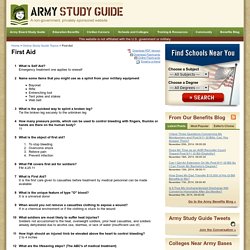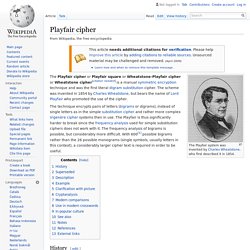

Basic Self-Defense Moves Anyone Can Do (and Everyone Should Know) Online Army Study Guide - First Aid. What is Self Aid?

Emergency treatment one applies to oneself Name some items that you might use as a splint from your military equipment BayonetRifleEntrenching toolTent poles and stakesWeb belt What is the quickest way to splint a broken leg? Tie the broken leg securely to the unbroken leg How many pressure points, which can be used to control bleeding with fingers, thumbs or hands are there on the human body? What is the object of first aid? To stop bleedingOvercome shockRelieve painPrevent infection What FM covers first aid for soldiers? What is First Aid? It is the first care given to casualties before treatment by medical personnel can be made available What is the unique feature of type "O" blood? It is a universal donor When would you not remove a casualties clothing to expose a wound? If in a chemical environment or if the clothing is stuck to the wound. INFP Personality (“The Mediator”)
Mediator personalities are true idealists, always looking for the hint of good in even the worst of people and events, searching for ways to make things better.

While they may be perceived as calm, reserved, or even shy, Mediators have an inner flame and passion that can truly shine. Comprising just 4% of the population, the risk of feeling misunderstood is unfortunately high for the Mediator personality type – but when they find like-minded people to spend their time with, the harmony they feel will be a fountain of joy and inspiration. Being a part of the Diplomat Role group, Mediators are guided by their principles, rather than by logic (Analysts), excitement (Explorers), or practicality (Sentinels). When deciding how to move forward, they will look to honor, beauty, morality and virtue – Mediators are led by the purity of their intent, not rewards and punishments. We Know What We Are, but Know Not What We May Be Listen to Many People, but Talk to Few. Skinner and chomsky. Playfair cipher. The Playfair cipher or Playfair square or Wheatstone-Playfair cipher or Wheatstone cipher[citation needed] is a manual symmetric encryption technique and was the first literal digram substitution cipher.

The scheme was invented in 1854 by Charles Wheatstone, but bears the name of Lord Playfair who promoted the use of the cipher. The technique encrypts pairs of letters (bigrams or digrams), instead of single letters as in the simple substitution cipher and rather more complex Vigenère cipher systems then in use. The Playfair is thus significantly harder to break since the frequency analysis used for simple substitution ciphers does not work with it. The frequency analysis of bigrams is possible, but considerably more difficult. With 600[1] possible bigrams rather than the 26 possible monograms (single symbols, usually letters in this context), a considerably larger cipher text is required in order to be useful.
History[edit] Superseded[edit] Description[edit] Example[edit] Cryptanalysis[edit] 5 Simple Rules You Must Learn to Build Basic Spanish Sentences. You understand what’s going on, sort of.

You can sing along to a few Spanish songs, you get the gist of basic conversation, but you can’t string a sentence together. Sound familiar? The most likely explanation is that you simply haven’t learned about basic Spanish sentence construction. But isn’t it the same as in English? I hear you cry. Why Learn the Basics of Spanish Sentences? Once you get these simple rules down, you’ll be able to construct more complex sentences. And that thing about Spanish and English not being the same.
So pay attention, because you’re about to learn the building blocks for your future Spanish-speaking life. 5 Simple Rules You Must Learn to Build Basic Spanish Sentences 1. To make a normal, affirmative sentence, you need a subject and a verb. For more on forming the present tense, see this post. And that’s all you need: subject and verb! To make things even easier, it’s often possible to omit the subject once we know who we are talking about. 2. 3. Bueno → bien 4. 5.